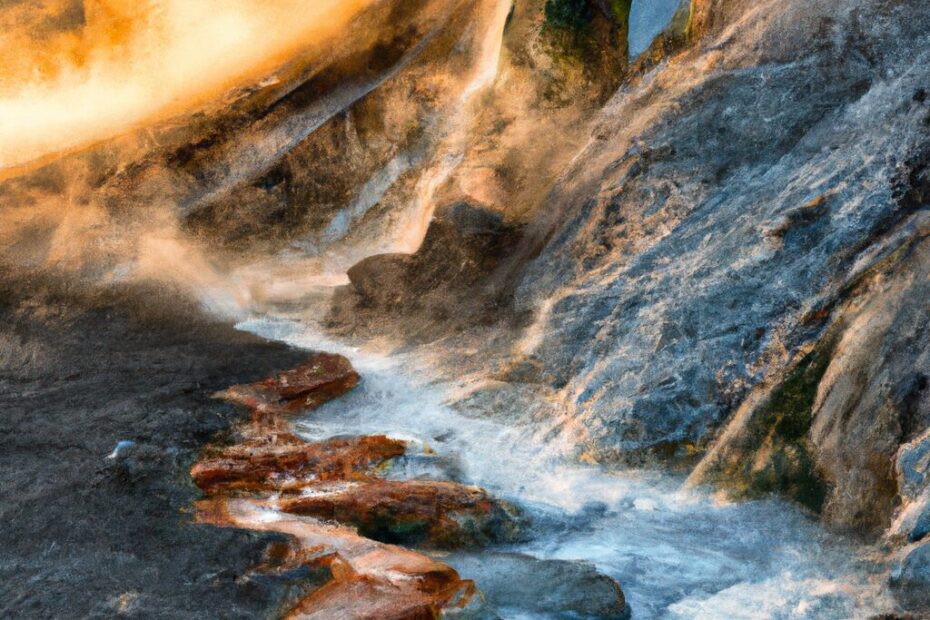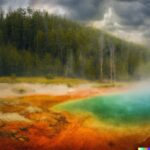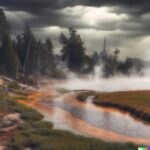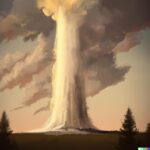Yellowstone National Park is home to a mesmerizing array of thermal features, from spouting geysers to bubbling hot springs. But have you ever wondered what causes these incredible natural wonders?
In this article, we’ll explore the volcanic and hydrothermal activity that creates Yellowstone’s thermal features. We’ll also take a closer look at the different types of thermal features found in the park, and where you can go to see them. Plus, we’ll provide some tips for safely enjoying and viewing these remarkable geological phenomena.
So, grab your hiking boots and get ready to discover the magic of Yellowstone’s thermal features!
What Causes Yellowstone’s Thermal Features?
Yellowstone’s thermal features are primarily caused by a combination of volcanic activity and hydrothermal processes, shaped by the park’s unique geology and geological history.
Yellowstone’s unique geothermal features are a result of magma and heat being released from the Earth’s mantle, creating a hot subsurface reservoir. The park’s geology, characterized by an extensive system of fractures and faults, allows water to seep deep into the crust.
As this water interacts with the hot rocks, it becomes heated and rises back to the surface, carrying dissolved minerals. This intricate process gives rise to the iconic geysers, hot springs, fumaroles, and mud pots that define Yellowstone’s otherworldly landscape.
Volcanic Activity
Volcanic activity plays a pivotal role in shaping Yellowstone’s thermal features, with the park resting upon the Yellowstone caldera, a hotspot for geothermal phenomena.
This geological wonderland is home to numerous hot springs, geysers, and fumaroles, all of which are direct results of the underground heat from the Yellowstone caldera.
The presence of geothermal sources creates an environment where water is heated, causing it to rise to the surface, forming the iconic geysers that enchant visitors.
The continuous volcanic activity beneath the surface keeps the unique thermal features active, making Yellowstone a living laboratory that offers insights into the Earth’s geologic processes and the power of geothermal energy.
Hydrothermal Activity
The hydrothermal activity in Yellowstone nurtures a diverse range of geothermal features, including mesmerizing thermal pools and captivating hydrothermal formations, contributing to the park’s unique ecosystem.
This complex system of hydrothermal activity plays a crucial role in sculpting the geothermal landscape of the park. The emergence of spectacular features such as geysers, fumaroles, and mud pots is a result of the underground volcanic processes. These processes continuously release heat and mineral-rich waters, creating remarkable formations.
The presence of these thermal features also creates a dynamic environment, supporting a variety of thermophilic microorganisms. These organisms thrive in the extreme conditions, adding to the ecological diversity of Yellowstone.
Types of Yellowstone Thermal Features
Yellowstone boasts a diverse array of thermal features, including geysers, hot springs, fumaroles, mud pots, and other enchanting hydrothermal phenomena, each showcasing the park’s unique geothermal wonders.
Geysers, such as the iconic Old Faithful, erupt hot water and steam high into the air at regular intervals, creating captivating spectacles. Hot springs are characterized by their vibrant colors, resulting from thermophiles, heat-loving microorganisms, thriving in the scalding waters. Fumaroles release steam and gases, often accompanied by a distinct sulfuric odor, adding an otherworldly ambiance. Mud pots, featuring bubbling mud and gurgling sounds, add a dynamic element to the diverse thermal landscape of Yellowstone National Park.
Geysers
Geysers stand as one of Yellowstone’s most iconic thermal features, captivating visitors with their mesmerizing eruptions and their association with the park’s distinctive volcanic landscape.
Their eruptive behavior is a sight to behold, as scalding water shoots skyward in powerful bursts, accompanied by billows of steam and vibrant hues of mineral deposits, creating a mesmerizing display.
These geothermal wonders provide a fascinating glimpse into the geological processes at work beneath the Earth’s surface, showcasing the powerful forces that have shaped Yellowstone’s dynamic and diverse terrain over millions of years.
The interplay of heat, water, and pressure within the Earth’s crust has given rise to these natural phenomena, leaving an indelible mark on the park’s unparalleled volcanic landscape.
Hot Springs
Yellowstone’s hot springs showcase a vibrant display of colors, often adorned with captivating bacterial mats, adding to the allure of these unique hydrothermal formations within the park.
These mesmerizing hot springs are a result of hydrothermal activity, which creates an otherworldly landscape.
The vivid hues, ranging from brilliant turquoise to fiery orange, are a testament to the diverse microbial life thriving in the extreme conditions. Observing these colorful pools is like witnessing nature’s artistry at its finest, where the interplay of light and minerals produce a visual symphony that captivates visitors from around the world.
Fumaroles
Fumaroles in Yellowstone emit mesmerizing steam and carry a distinct sulfurous odor, fostering the growth of heat-loving microorganisms, adding to the park’s unique geothermal allure.
These fumaroles, also known as steam vents, release steam due to the interaction of groundwater with the superheated rocks beneath the Earth’s surface. The sulfur present in the fumarolic emissions gives rise to the characteristic rotten egg smell that permeates the air around these vents. These unique geothermal features also provide a habitat for thermophilic microorganisms, forming specialized ecosystems that thrive in the extreme heat and chemical conditions of the fumaroles.
Mud Pots
The intriguing mud pots of Yellowstone feature boiling water and acidic pools, creating a captivating display of geothermal activity within the park’s diverse thermal landscape.
The hydrothermal formations found in this park are known for their bubbling and churning water, which often emits steam and creates a visually stunning spectacle. These pools are highly acidic, as seen in the vibrant mineral deposits that display shades of orange, yellow, and green. The constant gurgling and gushing of boiling water from deep within the earth adds to the otherworldly atmosphere, giving visitors a glimpse into the powerful forces that have shaped the park’s unique geology.
Travertine Terraces
The travertine terraces at Mammoth Hot Springs showcase the mesmerizing beauty of limestone deposits sculpted by geothermal activity, offering visitors a captivating display of Yellowstone’s unique thermal features.
The ongoing deposition of calcium carbonate from hot springs water over thousands of years has resulted in these stunning terraces, forming intricate patterns and vibrant colors that change with the seasons.
The interaction between the mineral-rich water and the unique microorganisms living in the hot springs creates a dynamic environment, constantly reshaping and renewing the terraces, making each visit a new and wondrous experience.
These travertine terraces stand as a testament to the fascinating geological processes that shape the natural wonders of Yellowstone National Park.
Where Can You Find Yellowstone’s Thermal Features?
Yellowstone’s thermal features are scattered across the park, with notable concentrations in the Upper, Midway, Lower, Norris, and West Thumb Geyser Basins, each offering a unique showcase of geysers, hot springs, and fumaroles.
Exploring the Upper Geyser Basin allows visitors to witness the famous Old Faithful geyser, along with other hydrothermal features.
Moving to the Midway Geyser Basin, the star attraction is the Grand Prismatic Spring, renowned for its vibrant colors.
The Lower Geyser Basin presents a wide array of geysers and hot springs, while the Norris Geyser Basin boasts the park’s tallest and most active geyser, Steamboat Geyser.
The West Thumb Geyser Basin is positioned alongside Yellowstone Lake, providing geothermal wonders against the stunning backdrop of the lake’s natural beauty.
Upper Geyser Basin
The Upper Geyser Basin, home to the renowned Old Faithful, is a hotspot for geothermal wonders, hosting a mesmerizing array of geysers and other thermal features that captivate visitors.
Visitors are enchanted by the rhythmic eruptions of the Castle Geyser and the vibrant hues of the Morning Glory Pool. The basin’s landscape is adorned with bubbling hot springs, colorful mineral deposits, and towering geothermal vents, creating a surreal and otherworldly atmosphere.
Tourists can experience the awe-inspiring power of nature as they wander the boardwalks, witnessing steam billowing from various geological marvels. The presence of such diverse geological formations makes the Upper Geyser Basin an unparalleled destination for those seeking a deeper understanding of Earth’s natural processes.
Midway Geyser Basin
The Midway Geyser Basin hosts captivating thermal features, including the stunning Grand Prismatic Spring and the imposing Excelsior Geyser, offering visitors a mesmerizing glimpse into Yellowstone’s geothermal wonders.
The vibrant hues of the Grand Prismatic Spring, created by thermophiles thriving in the mineral-rich waters, are truly a sight to behold.
The Excelsior Geyser, with its powerful eruptions and massive crater, commands attention and leaves a lasting impression on all who witness its display.
These unique hydrothermal formations showcase the raw power and beauty of nature’s geothermal wonders, making the Midway Geyser Basin a must-see destination for any enthusiast of earth’s natural marvels.
Lower Geyser Basin
The Lower Geyser Basin presents visitors with captivating geothermal wonders, featuring the enchanting Fountain Paint Pot and a diverse array of geothermal features, including mesmerizing mud pots.
The unique thermal attractions found within the basin create a truly otherworldly experience.
The Fountain Paint Pot, with its vibrant and ever-changing hues, captivates onlookers with its rhythmic bubbling and steamy releases.
Venturing further, visitors encounter a mesmerizing display of mud pots, each with its distinct character and activity.
From the gurgling and explosive bursts to the tranquil, simmering pools, the basin’s geothermal features offer a mesmerizing glimpse into the earth’s untamed forces.
Norris Geyser Basin
The Norris Geyser Basin offers a mesmerizing display of geothermal activity, featuring captivating steam vents and a diverse array of hydrothermal features that showcase the park’s unique geothermal landscape.
Visitors to the basin can witness a dynamic interplay of bubbling hot springs, colorful thermal pools, and the iconic Steamboat Geyser, which holds the distinction of being the world’s tallest active geyser.
The ethereal hissing sounds emanating from the fumaroles add to the otherworldly atmosphere, while the distinct sulfuric aroma further intensifies the sensory experience.
The basin’s geothermal wonders truly embody the raw power and beauty of nature’s volcanic manifestations.
West Thumb Geyser Basin
The West Thumb Geyser Basin, nestled along the shores of Yellowstone Lake, offers a captivating showcase of hydrothermal features, creating a unique juxtaposition of geothermal wonders against the park’s scenic water landscapes.
The basin’s hydrothermal attractions include colorful hot springs, bubbling geysers, and mesmerizing fumaroles. These features contribute to the area’s dynamic geothermal displays, creating a unique and otherworldly ambiance. The warm waters also support a vivid palette of microbial mats, adding an ethereal touch to the landscape.
As visitors explore, they can witness the interplay of steam rising from the earth’s depths against the tranquil expanse of Yellowstone Lake. This breathtaking natural spectacle highlights the raw power and beauty of geothermal activity within the park.
How to Safely View and Enjoy Yellowstone’s Thermal Features
To safely experience Yellowstone’s thermal features, visitors are advised to adhere to safety guidelines, stay on designated trails, and utilize boardwalks to observe and appreciate the park’s geothermal wonders.
A crucial aspect of preserving the natural beauty of Yellowstone and ensuring visitor safety is to always follow the instructions provided by park rangers and signs.
Venturing off designated pathways can be extremely hazardous due to unstable ground, scalding water, and toxic gases. By utilizing the approved boardwalks, not only can visitors safely enjoy the thermal features, but they also contribute to the preservation of the delicate geothermal ecosystem.
We must collectively remain responsible stewards of this unique and awe-inspiring natural wonder.
Stay on Designated Trails
Staying on designated trails and boardwalks is crucial for ensuring visitor safety and minimizing the environmental impact on Yellowstone’s delicate geothermal landscapes. This offers an immersive yet responsible way to experience the park’s thermal wonders.
Visitors can admire the vibrant hot springs, bubbling mud pots, and stunning geysers of Yellowstone National Park by following designated paths. This helps preserve the fragile geothermal formations and protects the park’s diverse wildlife. By staying on marked trails, responsible tourism practices contribute to the overall protection of Yellowstone’s ecological balance. This allows visitors to enjoy an enriching experience while respecting the environment.
Observe Warning Signs
Visitors to Yellowstone should diligently observe warning signs and safety advisories near thermal features, promoting environmental conservation and respecting the park’s natural wonders and geothermal landscapes.
These measures are crucial to ensure the preservation of delicate ecosystems and prevent damage to the unique geothermal formations.
By adhering to these safety protocols, visitors show their dedication to responsible environmental behavior, which is essential for the ongoing protection of Yellowstone’s natural beauty. By following these guidelines, individuals contribute to the sustainability of the park for future generations, instilling a culture of conservation and respect for our planet’s natural wonders.
Do Not Touch or Enter the Thermal Features
It is imperative for visitors to refrain from touching or entering the thermal features in Yellowstone, particularly geysers and hot springs, to ensure both personal safety and the preservation of these unique natural wonders.
These geothermal features are not only stunning to behold but also inherently dangerous due to their scalding temperatures and delicate ecosystems. Caution signs and designated boardwalks are in place to guide visitors and mitigate unnecessary risks.
The integrity of these natural formations depends on our collective responsibility to respect and protect them. By observing safety measures and keeping a safe distance, visitors play a crucial role in safeguarding Yellowstone’s geothermal features for future generations to enjoy.
Be Prepared for Changing Weather and Temperatures
Visitors should be prepared for fluctuating weather conditions and temperature changes when exploring Yellowstone’s thermal features, ensuring personal comfort and readiness to encounter the park’s diverse wildlife amidst its captivating geothermal landscapes.
When visiting a national park, it’s important to dress in layers to prepare for changing temperatures throughout the day. This can range from chilly mornings to potentially warmer afternoons. It’s also a good idea to bring a waterproof jacket and wear sturdy, comfortable footwear to adapt to any unexpected weather changes.
Additionally, it’s crucial to be aware of wildlife safety while exploring the park. Encounters with bison, bears, and other animals are possible, so it’s important to understand and follow the park’s wildlife viewing guidelines. Keeping a safe distance from animals not only ensures visitor safety but also helps preserve the park’s natural ecosystem.
Frequently Asked Questions
What are thermal features in Yellowstone National Park?
Thermal features in Yellowstone National Park refer to the various geothermal features found in the park, including geysers, hot springs, mudpots, and fumaroles.
What is a geyser?
A geyser is a type of thermal feature that shoots hot water and steam into the air periodically. Old Faithful is the most famous geyser in Yellowstone National Park.
Are thermal features safe to visit in Yellowstone?
While thermal features can be beautiful and fascinating to observe, they can also be dangerous. Visitors should always follow park regulations and stay on designated boardwalks and trails to avoid injury.
Do thermal features have different colors?
Yes, thermal features in Yellowstone can have a variety of colors, ranging from brilliant blue and green to vibrant orange and red. These colors are caused by different types of bacteria and minerals found in the water.
How can I learn more about thermal features in Yellowstone National Park?
The park offers guided tours and educational programs on thermal features, as well as informational signs and brochures at major thermal areas. Additionally, rangers are available to answer any questions you may have.
What should I do if I encounter a thermal feature while hiking?
If you come across a thermal feature while hiking, do not approach or touch it. Stay on designated trails and never throw objects into thermal features, as this can disrupt their delicate balance and cause harm to the ecosystem.
Last Updated on January 25, 2024 by Jon Waraas – Originally Posted: January 25, 2024

I’m Jon Waraas, and I’ve been navigating the online world since 2006. By day, I’m the proud owner of some eCommerce gems, and by night, I’m the voice behind the adventures on Waraas.Com.
My heart, however, belongs to the wild beauty of Yellowstone National Park. I’ve got a collection of websites dedicated to sharing the wonders of this natural masterpiece. Oh, and did I mention? I’m currently building my own cabin inside the ghost town of Gilmore, Idaho – a cabin with tales to tell!
When I’m not immersed in the digital realm, you’ll find me lacing up my boots for a good hike or setting up camp under the star-studded sky.




